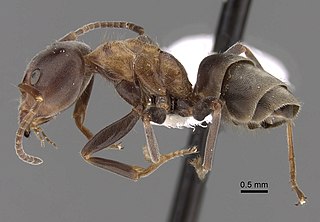
Escamoleseska'moles (help·info) are the edible larvae and pupae of ants of the species Liometopum apiculatum and L. occidentale var. luctuosum. They are harvested from the roots of the Agave tequilana (tequila) or Agave americana (maguey—mezcal) plants in Mexico. They are most commonly consumed in Mexico City and surrounding areas. Escamoles have been consumed in Mexico since the age of the Aztecs. They taste buttery and nutty, with a texture akin to that of cottage cheese.

Liometopum occidentale is a species of ants in the subfamily Dolichoderinae. Liometopum occidentale is often mistaken for carpenter ants by homeowners and pest management professionals. This mistaken identity is due to morphological and behavioral characteristics they share with carpenter ants; namely polymorphic workers, a smooth convex thoracic profile, and the tendency to excavate wood. Consequently, their importance as structural pests may be greatly under reported, especially in California, Oregon, and Washington, United States.

Liometopum luctuosum is a species of ants in the subfamily Dolichoderinae. Liometopum luctuosum is often mistaken for carpenter ants by homeowners and pest management professionals. This mistaken identity is due to morphological and behavioral characteristics they share with carpenter ants; namely polymorphic workers, a smooth convex thoracic profile, and the tendency to excavate wood. L. luctuosum are also often confused with the Tapinoma sessile since they have the same coloration, are similar in size, and produce an alarm pheromone with a very similar odor. Consequently, their importance as structural pests may be greatly under reported, especially in California, Oregon, and Washington, United States.

Liometopum apiculatum is a species of ant in the subfamily Dolichoderinae. Liometopum apiculatum ants are found in arid and semi-arid regions of southwestern United States and Mexico to Quintana Roo.
Liometopum crassinervis is an extinct species of Miocene ants in the genus Liometopum. Described by Heer in 1849, fossils of the species were found in Switzerland.
Liometopum escheri is an extinct species of Miocene ant in the genus Liometopum. Described by Heer in 1867, fossils of the species were found in Switzerland.

Liometopum imhoffii is an extinct species of ants in the dolichoderine genus Liometopum. The species was described from a number of Early Miocene fossils found in what is now Croatia.
Liometopum lindgreeni is a species of ant in the genus Liometopum. Described by Forel in 1902, the species is endemic to China and India.
Liometopum longaevum is an extinct species of Miocene ant in the genus Liometopum. Described by Heer in 1849, the fossils were found in Switzerland.

Liometopum microcephalum is a species of ant in the genus Liometopum. Described by Panzer in 1798, the species is endemic to Europe.
Liometopum miocenicum is an extinct species of ant in the genus Liometopum. Described by Carpenter in 1930, the fossils of this species are only exclusive to the United States.
Liometopum oligocenicum is an extinct species of Miocene ant in the genus Liometopum. Described by William Morton Wheeler in 9115, the fossils were found in Baltic amber.
Liometopum pallidum is an extinct species of Miocene ant in the genus Liometopum. Described by Heer in 1867, the fossils were found in Croatia.
Liometopum rhenana is an extinct species of Oligocene ant in the genus Liometopum. Described by Meunier in 1917, the fossils were found in Germany.
Liometopum scudderi is an extinct species of ant in the genus Liometopum. Described by Carpenter in 1930, the fossils of this species are only exclusive to the United States.
Liometopum sinense is a species of ant in the genus Liometopum. Described by William Morton Wheeler in 1921, the species is endemic to China.
Liometopum venerarium is an extinct species of Miocene ants in the genus Liometopum. Described by Heer in 1864, fossils of the species were found in Switzerland.
Liometopum ventrosum is an extinct species of Miocene ants in the genus Liometopum. Described by Heer in 1849, fossils of the species were found in Switzerland.
Liometopum incognitum is an extinct species of formicid in the ant subfamily Dolichoderinae known from fossils found in eastern Asia.







